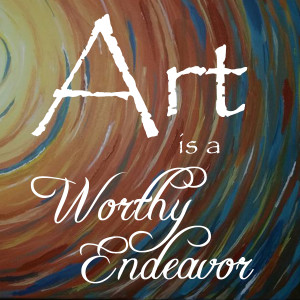Art is a Worthy Endeavor

If you are like me, and every other writer I know, you have about a million jobs. There is, of course, the writing, and then the marketing your own books, and then the marketing and writing you do on a freelance basis (because why not, I mean if there is anything you know, it’s how to craft words for a purpose).
And then there is your day job. Not to mention your volunteer activities.
And if you have kids, the above list is only the beginning.
My day job is that of a college English instructor. I teach a number of composition courses, and I am noticing a disturbing trend with my students: they do not value creativity. For them, it’s almost as if creativity is an “other,” something to pursue if one has the time and the talent. They enjoy art, but it is almost always secondary.
This shouldn’t come as a surprise. After all, we teach our children in an incredibly rigid school system of tests and metrics and checklists. From the time they are young, we ask them what they want to be when they grow up (as if most of us ever know). We sit them down in classrooms designed to keep their minds busy, loud, and stimulated. We devalue quiet thought for gregarious personalities and discovery for ability.
They sit in my classes, all hopeful and new, with one goal in mind: get college over with so they can graduate and get that job. And although gainful employment is absolutely necessary, this method of earning it is not always successful.
More than ever, we need creativity, even in our entry-level positions. Gone is the world where a student receives good grades, graduates, and then works in a factory where they earn a decent living making widgets. Now, there is no problem with industrial jobs—it’s just there aren’t enough of them to go around for the number of cogs we are creating for these types of positions.
I typically poll my students on the first day of classes and ask them how important they think creativity is to their education and to business. Overwhelmingly, they write it off as something to pursue after the “important” things in their lives are accomplished. And so convincing students of the need for creativity in their everyday lives has become yet another job for the college instructor.
Just go into any store and watch the cashiers for a while. Cashiering is considered an entry-level position (although anyone who has done the job will tell you it is not as easy as it looks). But even this position has changed. Everyone wants things faster, more accurate, and cheaper. Customers are impatient and do not handle problems well. Managers run from one stand to the next, harried and sweating, apologizing and fixing. The employees behind the register are frustrated because the technology is not working “as it should,” and the checklists posted everywhere around the keys of their register have nothing to do with how the real, dynamic experience of interacting with the public actually works.
They are paralyzed by the incongruences between how something is supposed to work, and how it actually does. But it is not their fault. We’ve raised them to follow rules, to check off the list, to pass the test and get from one grade to the next. We’ve sold them on the lie that their dream job will be waiting if only they finish college with a high GPA.
And we’ve failed them.
We’ve raised them to be cogs in a machine that no longer exists, when in reality the world needs flexible, dynamic inventors who see the value in a pliable mind that generates ideas more than it relies on rules.
This is where you, the writer, comes in.
Let’s be honest, we’ve bought into the lie too.
When someone asks you what you do, you probably mumble that you are a writer (if you mention it at all), because that’s not a “real” job, even though you’ve invested more time into your craft than you thought humanly possible. You downplay your contributions. You mention only those articles and books that are published.
And the world collapses just a bit every time you receive a rejection letter.
In short, you cram your identity as an inventor and a creative thinker into a hole that is more acceptable to the rest of the community.
But this robs our kids, because they follow your lead. They grow up understanding that art is something you do if you have free time, and creativity is secondary to work. When in reality, business thrives on creativity, and employers are hungry for problem solvers.
And what is a writer, if not a problem solver? We even go the extra step—we create the problems and then solve them! We don’t tell stories about safe people doing safe things in a safe environment. Mostly, because that doesn’t exist in real life. So why do we train our children to respond with safe answers to safe questions in safe places?
Live brave. Let your children, grandchildren, nieces, nephews, brothers, and sisters see you struggle. Let them see you create for the sake of creation. Let them see your disappointment when you fail to get that contract, and then how you bounce back and write again, because it isn’t really about publication, anyway.
Let them know they live in a world that needs their abilities and the unique perspective only they can bring.
And show them that art is a worthy pursuit, that creativity is necessary to life.
Then, when they sit in front of me waiting to learn, I do not have to first convince them that they are more than a cog. Instead, we can get right to the business of creating and problem solving and fixing those sentences because more than ever, the world needs them to be ready to tackle problems with confidence and create brave solutions.
First published on Christian Fiction Online Magazine
